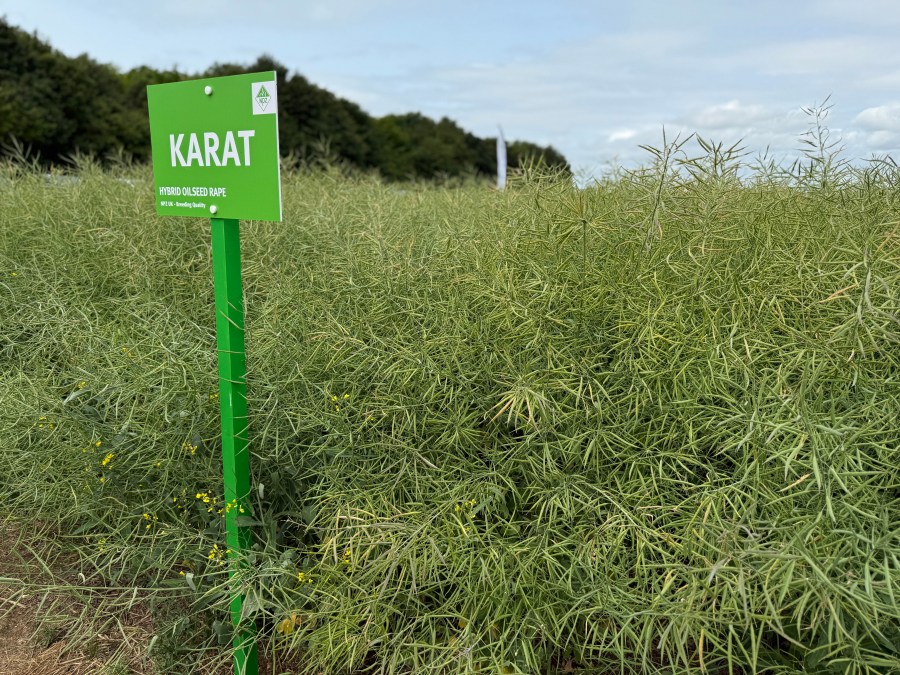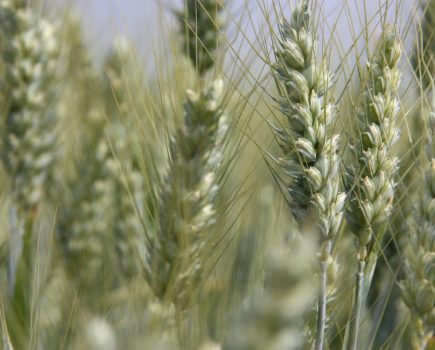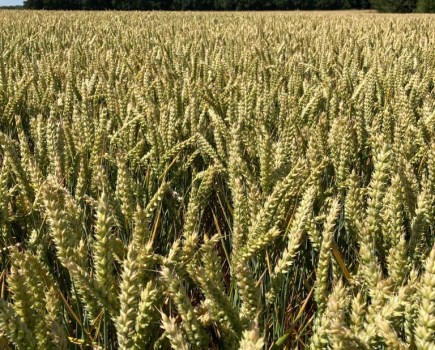Despite a challenging few years for the crop, innovation in oilseed rape breeding continues to evolve. CPM travelled to NPZ HQ in Cambridgeshire to learn more about its latest offerings and how to get the best from the break crop.
“We have to ask whether we still really know how to grow OSR.” RENE BRAND
By Charlotte Cunningham
It goes without saying that oilseed rape has experienced a challenging few years, with stagnating yields, shrinking acreage, and increasing pressure from climate and pests leaving many growers at a crossroads regarding whether or not to continue with the break crop.
Indeed, the numbers are sobering: from more than 700,000ha of OSR a decade ago, the UK now grows just 240,000ha. Average yields have also fallen dramatically during the past five years alone, placing the UK at the bottom of European rankings.
However, as NPZ celebrated 20 years of breeding innovation last month, the message was clear – OSR still has a vital role to play in UK arable rotations, especially when backed by robust research, improving genetics, and better guidance for growers.
This is according to the company’s Michael Shuldham, who welcomed growers to a celebratory open day to mark the milestone at NPZ’s HQ in Cambridgeshire. He believes there’s still plenty of opportunity for the crop.
The scene was set with a stark yet familiar observation – it’s been dry. Not just here in the UK, but across Europe. This has had significant implications for OSR production across the EU and UK, with a total drilled area of 8.8M hectares – already falling short of anticipated demand.
“This is a positive sign for prices,” says Michael, highlighting a projected harvest of 18.6M tonnes against a consumption requirement of 19.4M tonnes. “That’s a notable deficit, and one that puts UK growers in a strong position.
“As we often say, if the price of OSR is more than twice that of wheat, it’s a good time to consider planting. At the moment, that ratio is sitting at 2.3–2.4 to wheat – so the signal is strong.”
With prices buoyed by the fundamentals, attention turns to where growers can find confidence in the crop and capitalise on this. It comes down to one thing…yield.
However, with yields declining nationally, NPZ’s Rene Brand says the issue isn’t just about performance, it’s about perspective. “We have to ask whether we still really know how to grow OSR. Have we adapted our agronomy to the changing hybrids and climate conditions? Are our trials truly reflective of the questions farmers are facing in the field?”
The core of Rene’s argument lies in a simple but overlooked truth: while breeding has continued to deliver genetic gains – yield increases of 1 to 1.5% annually – this potential isn’t making it through to farm level. “Independent trial data confirms that around 66% of yield progress in OSR is directly attributable to breeding,” he points out. “But if that progress is getting lost between the trial plot and the farm gate, we have to ask ourselves why?”
CLIMATE CHANGE
So where do growers go from here? Rene says climate change is having a more profound yet poorly understood impact on OSR than many realise, especially during autumn establishment. It’s his view that by learning more about this and adapting practices in line with the science could help to unlock some of this yield potential.
“OSR switches from the vegetative to generative phase at around the six-leaf stage, triggered by an accumulated thermal temperature of around 600oC,” he explains. “In the past, that happened slowly. Now, with higher autumn temperatures, that process accelerates – and the reduction of side branches starts before we’ve even had a chance to apply fertiliser.
“Our own temperature data from sites like Cambridge show that accumulated temperatures in autumn are now reaching 1300-1400oC, compared with the 800-1000oC range that OSR requires for optimal development in the UK. The crop is simply overgrowing before winter which increases its vulnerability.”
Despite this, few growers appear to be adjusting their sowing dates. A survey conducted by CPM last year found most still favour early drilling – even though warmer autumns and faster growing hybrids mean the crop establishes too aggressively.
Rene warns this can lead to excess biomass, increased disease risk, and even reduced winter resilience – especially when compounded by widespread use of vigorous, virus-resistant hybrids. “These varieties brought a 10% yield lift when first introduced, but they also grow 10% stronger – so when combined with warm autumns, we’re seeing higher risks of bolting and structural breakdown before winter even arrives.”
To counter this, the NPZ team has been championing late sowing strategies, trialled extensively across the UK and Europe. “At last year’s Cereals Event, we showcased side-by-side comparisons between standard and late sowing. The results were clear – later sowing delivered stronger rooting, better pod set, and more consistent yields, especially with new, healthier genetics.”
These findings have led to broader trials, incorporating later sowing with other management tactics such as fungicide intensity and the use of seed treatments. One standout is the inclusion of seed-applied biostimulants and treatments like Lumiposa (cyantraniliprole) and Integral Pro (bacillus amyloquefaciens), which have shown promise in improving early vigour and yield stability – particularly when establishment conditions are less than ideal, notes Rene.
“We had plots last autumn that looked so poor we considered terminating the trial. But by spring, the treatments had kicked in and the crop recovered remarkably, proving that late sowing, coupled with the right inputs, has real potential.”
Looking at the new varieties and NPZ has a vast pipeline of innovative options coming through to market. Of note, this includes Maverick – the current leader of the UK Recommended List – a hybrid that encapsulates NPZ’s modern breeding ethos: disease resistance, agronomic strength, and yield stability, says Rene.
“Maverick is the result of an incredibly strong parentage. The mother line – MSL 325 – is one of the strongest on the continent. It comes from DSV; we’re partners on the breeding side, even if we’re competitors in sales,” he laughs.
Paired with the father line – HC 171 – Rene believes Maverick is a ‘game-changer’. “There’s more than 10 years of intensive selection work in UK conditions behind this variety. It carries turnip yellow virus resistance, stem canker resistance via the Rlm7 and RlmS genes, and strong light leaf spot resistance. That combination is what’s made it successful not just here, but also in markets like Denmark.”
It’s not just about resistance though. Yield potential, oil content and lodging resistance all come together to form a package Rene says is as complete as any they’ve seen, and it’s already setting the benchmark for what’s next.
Other varieties from NPZ include Turing – an older variety which Rene believes still packs a punch, claiming the fifth spot on the RL with 106% output. Then there’s Murray and Vegas – both early to market with RlmS resistance and moderate verticillium tolerance. “Vegas particularly shows good oil content and strong spring growth,” adds Rene. “Different architecture, but very comparable in output — both sit at 104% on the RL.”
SHINING FUTURE
But what about the future of breeding at NPZ? Considering the firm’s current candidates, there’s one in particular which looks like it’s worth its weight in gold…
With trial yields of 108% and 110% in the UK and boasting a new genetic resistance against stem canker is Karat – the candidate which looks set to change the game in the fight against phoma.
“Rlm12 represents a new mode of action versus existing genes like Rlm7 or RlmS, which should support more sustainable resistance management,” explains Rene. “We’re seeing resistance levels on par with Maverick and that’s no small feat.”
So what exactly is it? To recap on the deep dive into Rlm12 in the June issue of CPM, Rlm12 is a new resistance against Leptosphaeria maculans, the pathogen behind phoma stem canker, and has been discovered from within NPZ’s elite breeding material.
In terms of how it works, while resistance genes such as Rlm3, Rlm5 and the widely used Rlm7 have formed the bedrock of phoma leaf spot control in OSR for years, their primary action has been focused on the cotyledon stage – offering protection early on, but with vulnerabilities as the crop matures. “Those genes do a decent job at the front-end managing leaf lesions,” explains Michael. “But over time, we’ve seen these resistances erode especially under sustained pathogen pressure.”
In newer genetics like Rlm12 and RlmS, which are both classified by NPZ as adult plant resistance genes, these work later into the crop’s development, halting the pathogen’s progression from the leaf into the petiole and crucially, preventing stem infection.
“And that’s where it really matters,” stresses Michael. “Stem canker is the real yield thief – it can cause lodging, early senescence, and severely restrict nutrient uptake.”
By interrupting the disease at this later, more damaging stage, Rlm12 brings a more durable, yield-preserving layer of protection to the table. And when stacked with other resistance traits, its value is even greater – providing growers with a more robust line of defence in the ongoing battle against phoma.
Karat is the first variety to feature Rlm12, stacking it alongside RlmS to both enhance phoma resistance and protect genetic longevity. Of course, no variety can rely on just one trait, but Karat delivers on multiple fronts, states NPZ’s Craig Padley. “Early data suggests strong autumn and spring vigour, and it’s one of the best all-round disease packages currently on the Candidate List.”
Headline characteristics from trials to date include an 8 for light leaf spot resistance, as well as good internal trial performance against verticillium wilt, “It’s also showing promising signs of tolerance to sclerotinia which is a notoriously tricky disease,” says Craig.
“We’re not talking about resistance – there’s no known gene for that. But Karat has shown a good ability to slow the progression of the pathogen, which translates into better stem health overall.”
Karat is up for recommendation this year with NPZ confident in its positioning across the UK – but particularly as a frontrunner in the East and West. “That’s where its combination of stem canker and leaf spot resistances will be most valuable,” explains Craig.
“It’s top of the candidate list in that region. And while we expect it to perform further north too – especially with that LLS resistance – its real home is likely to be further east.”
Perhaps interestingly, Karat is being pushed into markets beyond the UK, with strong performance noted in German trials where it’s also one of the top candidates for recommendation, he adds.
LATER DRILLING
With increasing interest in later sowing windows as explored earlier, Karat has been part of NPZ’s late-sown trials too, and early indications are positive. “It’s looked good so far in that slot,” says Craig. “But as always, we’re waiting on yield data before making any bold claims. This season has been full of surprises so we’re cautiously optimistic.”
So, what’s the takeaway? Karat may be a fresh face, but its credentials suggest a well-rounded, consistent performer with a genuinely novel disease resistance package at its core. “We’ve seen consistency across trial sites this year,” concludes Craig. “It’s ticking the right boxes agronomically and commercially – and we’re expecting some strong results come harvest.”
Although not quite at the same stage of readiness as Karat, NPZ also has several other candidates in the pipeline which look set to offer new and different solutions to OSR growers.
Arguably one of the most intriguing lines is a Polish-bred hybrid known simply at present as ‘42’. “What’s exciting here is the genetic contribution from Eastern Europe – particularly the continental climate stress selection,” explains Rene. “This hybrid brings a strong improvement in pod shatter tolerance which is a crucial trait as we push for harvest resilience.”
With a yield performance of 106% relative in the latest trial year, 42 stands out not only for its physical robustness but also its suitability to growers seeking yield stability under climatic pressure, he notes.
Another candidate, developed in collaboration with DSV and known internally as 49, has caught NPZ’s eye for its impressive autumn growth and rapid post-winter regrowth. “It’s particularly strong in terms of early flowering which could be a big win for those looking to spread the flowering window or get ahead of spring pest pressure.”
Similarly, candidate 41 has delivered consistent results in official trials, again delivering a relative yield of 106%. With solid virus resistance, as well as light leaf spot tolerance, it’s a continuation of NPZ’s plant health-focused breeding direction, adds Rene.
Another promising entry is Dirigent – sharing the same reliable mother line seen in Vegas and Murray, but with an upgraded father line. With trial results of 110% and 107%, it’s on par with Karat in terms of output. And while its disease resistance package is slightly less extensive – featuring virus and phoma resistance via Rlm7, but not light leaf spot – it still brings valuable strength to the portfolio, believes Rene.
As breeders look to the future of UK OSR production, it’s evident that an emphasis on health, harvest resilience, and robust autumn performance will continue to define the varieties that rise to the top.
“We must stop thinking of OSR as a static crop. The environment, the varieties, the threats – they’re all changing. We must evolve our management accordingly, and this means moving away from the default,” concludes Rene.
“The UK OSR sector is under pressure, no doubt. But we believe there’s a path forward. Late sowing, smarter inputs, and making better use of modern genetics – this is how we bridge the gap between potential and reality.”
This article was taken from the latest issue of CPM. Read the article in full here.
For more articles like this, subscribe here.
Sign up for Crop Production Magazine’s FREE e-newsletter here.




